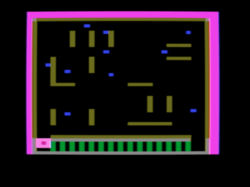Firebug (video game)
| Firebug | |
|---|---|
 The use of the Apple II's lo-res graphics mode made Firebug look blockier, but more colorful, than most Apple II games. | |
| Developer(s) | MUSE Software |
| Publisher(s) | MUSE Software |
| Designer(s) | Silas Warner |
| Platform(s) | Apple II |
| Release date(s) | INT 1982 |
| Mode(s) | Single-player |
Firebug was a 1982 computer game by MUSE Software for the Apple II computer. The game was released on cassette tape and on floppy disk.[1] It was written by Silas Warner, whose most famous accomplishment was Castle Wolfenstein.
The player controlled a "firebug", a 3-by-3-pixel square with a tail stretching behind it. The player picked up gas cans—each represented by a single pixel on the screen—and dropped a can by pressing the joystick button. The end of the player's tail glowed white, and ignited any gas can that it came adjacent to, including cans the player had dropped. Once a gas can ignited, it burst into colorful flames, which ignited any walls they touch.
The goal was to burn down the highest possible percentage of the walls on the level, and escape down the stairs to the next level without touching any flames with the body of the firebug. Tail collisions with fire were expected and ignored. As the game progressed, each level featured tighter mazes of walls, increasing the penalty for player mistakes; and the player's tail shortened, causing player-dropped gas cans to explode sooner.
Firebug used the Apple II's lo-res graphics mode, which displayed 16 colors but which had a pixel resolution of only 40 wide by 48 high. Hence, the game looked remarkably crude, even by the standards of Apple II games. At the time, the colorful fire effect was notable.
The game was an inspiration for Pyro 2.
Firebug was not critically well received.[2]
External links
References
| ||||||||||||||||||||||||||||